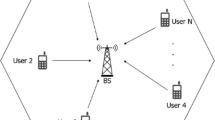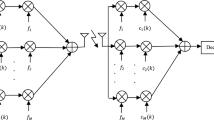Abstract
In Code Division Multiple Access (CDMA) radio environments, the maximum number of supportable users per cell is limited by multipath fading, shadowing, multiple access interference and near-far effects which cause fluctuations of the received power at the base station. In this context, power control and signal detection are essential to provide satisfactory Quality of Service (QoS) and to combat the near-far problem in CDMA systems. In this paper, we raised the uplink power control problem for a generalize asynchronous direct-sequence (DS) CDMA system that explicitly incorporate into the analysis: (1) the propagation delays in the network (generally neglected in the literature), (2) the adverse effect of multipath fading for wireless channels, and (3) the asynchronous transmissions in the uplink channels. This framework is used to propose a distributed power control strategy enhanced with linear multiuser receivers. It is shown that through a proper selection of an error function, the nonlinear coupling among active users is transformed into individual linear loops. A Linear-Quadratic-Gaussian (LQG) power control strategy is derived and compared with other approaches from the literature. Simulation results show that the uplink channel variations do not destroy the stability of these power control structures. However, delays in the closed-loop paths can severely affect the stability and performance of the resulting feedback schemes. It is also shown that the use of multiuser detection at the base station can bring significant improvements to the performance of power control.









Similar content being viewed by others
References
Schilling, D. L., Pickholtz, R. L., & Milstein, L. B. (1982). Theory of spread spectrum communications-a tutorial. IEEE Transactions on Communications, 30, 855–884.
Song, W. J. (2002). Evolutionary computation and power control for radio resource managementess in cdma cellular radio networks. In 13th IEEE international symposium, personal, indoor and mobile radio communications (Vol. 3, pp. 1417–1421).
Osery, A. E. (2000). Distributed power control in cdma cellular systems. IEEE Antennas and Propagation Magazine, 42(4), 152–158.
Gunnarsson, F., & Gustafsson, F. (2003). Control theory aspects of control in umts. Control Engineering Practice, 11, 1113–1125.
Yun, L. C., & Messerschmitt, D. G. (1994). Power control for variable qos on a cdma channel. In IEEE Proceedings of IEEE MILCOM (pp. 178–182). Fort Monmouth, NJ.
Yates, R. D. (1995). A framework for uplink power control in cellular radio systems. IEEE Journal on Selected Areas in Communications, 13(7), 1341–1347.
Arcak, M., Fan, X., & Wen, J. T. (2004). Passivation designs for cdma uplink power control. In Proceedings of the 2004 American control conference (pp. 3617–3621). Boston, USA.
Arcak, M., Fan, X., & Wen, J. T. (2004). Robustness of cdma power control against disturbances and time-delays. In Proceedings of the 2004 American control conference (pp. 3622–3627). Boston, USA.
Alpcan, T., Fan, X., Basar, T., Arcak, M., & Wen, J. T. (2008). Power control for multicell CDMA wireless networks: A team optimization approach. Wireless Networks, 14(5), 647–657.
Skataric, D., Gajic, Z., & Koskie, S. (2004). Optimal sir-based power updates in wireless cdma communication systems. In 43rd IEEE conference on decision and control, Paradise Island, The Bahamas.
Qian, L., & Gajic, Z. (2006). Variance minimization stochastic power control in cdma systems. IEEE Transactions on Wireless Communication, 5(1), 193–202.
Chronopoulos, A. T., Jagannathan, S., & Ponipireddy, S. (2002). Distributed power control in wireless communication systems. In 11th International conference on computer, communications and network. Miami, FL.
Paul, A., Akar, M., Safonov, M. G., & Mitra, U. (2005). Adaptive power control for wireless networks using multiple controllers and switching. IEEE Transactions on Neural Networks, 16(5), 1212–1218.
Shakkottai, S., Rappaport, T. S., & Karlsoon, P. C. (2003). Cross-layer design for wireless networks. IEEE Communications Mag, 41, 74–80.
Dimic, G., Sidiropoulos, N. D., & Zhang, R. (2004). Medium acces control-physical cross-layer design. IEEE Signal Processing Magazine, 21(5), 40–50.
Saraydar, C. U., Mandayam, N. B., & Goodman, D. J. (2002). Efficient power control via pricing in wireless data networks. IEEE Transactions on Communications, 50(2), 291–303.
Meshkati, F., Poor, H. V., Schwartz, S. C., & Mandayam, N. B. (2005). An energy-efficient approach to power control and receiver design in wireless data networks. IEEE Transactions on Communications, 53(11), 1885–1894.
Buzzi, S., Massaro, V., & Poor, H. V. (2009). Energy-efficient resource allocation in multipath CDMA channels with bandlimited waveforms. IEEE Transaction on Signal Processing, 57(4), 1494–1510.
Buzzi, S., & Poor, H. V. (2008). Joint receiver and transmitter optimization for energy-efficient CDMA Communications. IEEE Journal on Selected Areas in Communications, 26(3), 459–472.
Meshkati, F., Guo, D., Poor, H. V., & Schwartz, S. C. (2008). A unified approach to power control in large energy-contrained CDMA systems. IEEE Transactions on Wireless Communications, 7(4), 1208–1216.
Popovski, P., Ingram, M. A., Peel, C. B., Hara, S., & Toumpis, S. (2009). Cross-layer design for the physical, MAC and link layer in wireless systems. EURASIP Journal on Advances in SIgnal Processing, 2009, Article ID 528675.
Campos-Delgado, D. U., Luna-Rivera, J. M., Martinez-Lopez, F. J. Distributed power control algorithms in the uplink of wireless cdma systems. Accepted for publication in IET Control Theory & Applications.
Verdu, S. (1998). Multiuser detection. Cambridge: Cambridge University Press.
Kim, D. (2001). On the convergence of fixed-step power control algorithms with binary feedback for mobile communications systems. IEEE Transactions on Communications, 49(2), 249–252.
Ogata, K. (1987). Discrete-time control systems. Englewood Cliffs : Prentice Hall.
Koskie, S., & Gajic, Z. (2005). A nash game algorithm for SIR-based power control in 3G wireless CDMA netwroks. IEEE Transactions on Networking, 13(5), 1017–1025.
Syrmos, V. L., & Lewis, F. L. (1995). Optimal control. London: Wiley.
Campos-Delgado, D. U., & Zhou, K. (2001). h ∞ strong stabilization. IEEE Transactions on Automatic Control, 46(12), 1968–1972.
Campos-Delgado, D. U., Luna-Rivera, J. M., & Martinez-Lopez, F. J. (2008). Dead beat and lq optimal power control algorithms in the uplink of wireless systems. In 2008 American control conference (ACC2008). Seattle, Washington, USA.
Acknowledgments
This research work was supported by CONACYT under the Grant No. 83811.
Author information
Authors and Affiliations
Corresponding author
Appendix
Appendix
Proof of Proposition 1 by direct substitution of (6) into (19), we get
or equivalently
If we define
and
then (19) is obtained. Hence the tracking error e i [k] in (19) is defined in a nonlinear way as a percentage error weighted by the power level. In fact, if e i [k] → 0 then \(\gamma_i[k] \rightarrow \gamma_i^{obj},\) since p i [k] ≠ 0. Also, the error is always well-defined, since γ i ≠ 0 for an active user. Finally, without loss of generality, it is assumed that \(|h_i[k]|^2 \neq 0\;\forall k\) and any active user. \(\square\)
Proof of Proposition 2 the Dead-Beat control law can be derived by observing the closed-loop relation between the output and reference:
where \(P_i(z)={\mathcal{Z}}\{p_i(k)\}\) and \(\hat{P}_i(z)={\mathcal{Z}}\{\hat{p}_i(k)\}\) denote the z -transforms of the power signal and its reference. Note that for Dead-Beat response, it is needed \(P_i(z)=z^{-n_{RT}}\hat{P}_i(z)\). Considering num i (z) = b0 and \(den_i(z)=a_0+a_1z^{-1}+a_2z^{-2}+\cdots+a_{n_p+n_m}z^{-(n_p+n_m)},\) then it is concluded that:
Consequently, the controller \(K^{DB}_i(z)\) in (28) is deduced. \(\square\)
Proof of Proposition 3 by a direct substitution of (29) into (30), the cost function J can be written as
The local stationary conditions for optimality are
Finally, from (49) and by arranging the time indices, the suboptimal control law in (31) is deduced. Next, the closed-loop stability is evaluated. The suboptimal control law \(\hat{K}_{SLQ}\) and open-loop plant G can be expressed in z-domain using a transfer function notation
The closed-loop characteristic equation \(1-\hat{K}_{SLQ}G=0\) is given by
Therefore, the closed-loop pole is \(0 < {\frac{r}{q+r}}<1,\;\forall q,r>0\). As a result, the feedback system is stable. \(\square\)
Proof of Proposition 4 the prediction error can be written using a vector notation:
where vectors \({\bf 1},{\bf Y},{\bf W}\in {\mathbb{R}}^{n_{RT}},\) and they are represented by
As a result, the prediction error can be written as
This cost function E can be further simplified by applying the statistical properties \({\mathcal{E}} \{ a_i(k) u_i(k-d) \}=0\;\forall k,d\) and \({\mathcal{E}}\{a_i^2(k)\}=\sigma_a^2 {\mathcal{E}} \{ u_i^2(k) \} = \sigma_u^2\;\forall k\) to obtain
where
Finally, the optimal stationary conditions are derived
Therefore, the optimal solution is given by
which is equivalent to (36). \(\square\)
Proof of Proposition 5 the control law in (37) is readily constructed by using the results from Proposition 3 in (37), and the optimal parameters in the estimation problem of Proposition 4 in (36). \(\square\)
Rights and permissions
About this article
Cite this article
Luna-Rivera, J.M., Campos-Delgado, D.U. Distributed power control algorithms for asynchronous CDMA systems in frequency-selective fading channels. Wireless Netw 17, 453–464 (2011). https://doi.org/10.1007/s11276-010-0290-y
Published:
Issue Date:
DOI: https://doi.org/10.1007/s11276-010-0290-y




